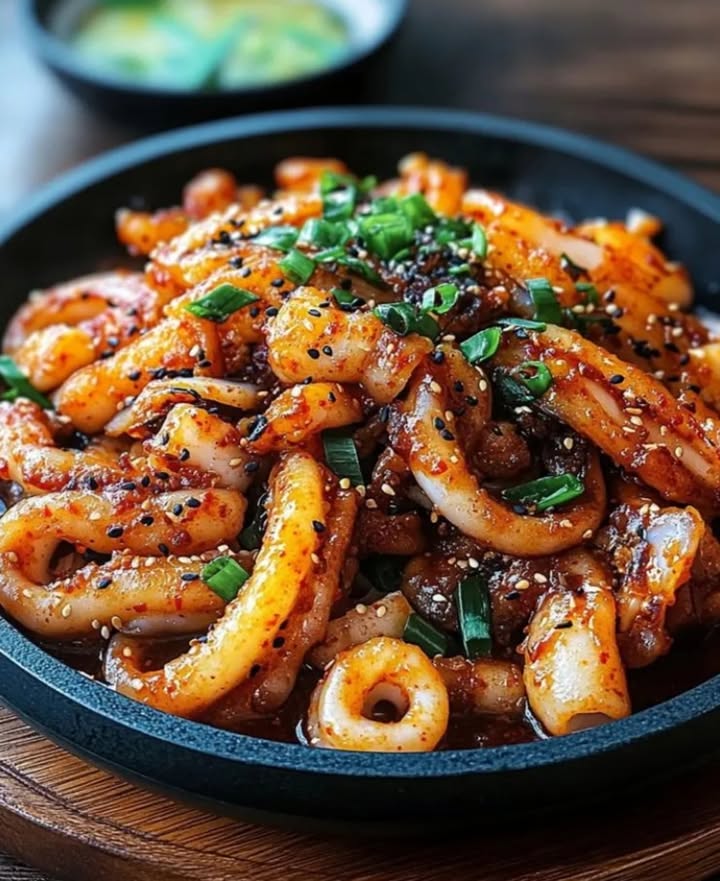
Picture this: you’re sitting at a bustling Korean restaurant, steam rising from a sizzling plate of tender octopus bathed in a fiery red sauce. The aroma hits you first—spicy, savory, with a hint of sweetness. One bite, and you’re hooked. That’s how I felt the first time I tried Spicy Korean Octopus, or Nakji-bokkeum. It’s bold, it’s vibrant, and it’s become one of my go-to dishes for impressing friends and family.
What Makes Spicy Korean Octopus So Special?
Spicy Korean Octopus is more than just a dish; it’s an experience. Originating from Korea, this recipe is a popular street food and home-cooked favorite. Traditionally, it’s made with fresh octopus stir-fried in a spicy gochujang-based sauce and served alongside rice. The dish is known for its perfect balance of heat, umami, and freshness. What fascinates me most is how versatile it is—you can tweak the spice level to suit your taste while still preserving its authentic flavors.
Why You’ll Love This Recipe
This Spicy Korean Octopus recipe is a winner for so many reasons. First, it’s packed with flavor. The combination of gochujang, garlic, ginger, and sesame oil creates a sauce that’s rich and complex. Second, it’s surprisingly easy to make. Even if you’re new to Korean cooking, you’ll find this dish approachable. Plus, it’s quick—ready in under 30 minutes! Whether you’re a fan of seafood or just love bold, spicy dishes, this recipe is sure to become a staple in your kitchen.
Perfect Occasions to Make This Dish
Looking for something impressive yet simple to serve at your next dinner party? Spicy Korean Octopus is your answer. It’s also perfect for casual weeknight dinners when you want something hearty but not too heavy. I’ve even made it for game nights—it pairs beautifully with cold beers or sparkling sodas. Trust me, once you try it, you’ll be making it for every occasion!
Ingredients List
- For the octopus:
- 500 g fresh or frozen octopus, cleaned and cut into bite-sized pieces
- 1 tbsp white vinegar
- 1 tsp salt
- For the spicy sauce:
- 2 tbsp gochujang (Korean chili paste)
- 1 tbsp gochugaru (Korean chili powder, optional for extra heat)
- 2 tbsp soy sauce
- 1 tbsp sugar
- 1 tbsp sesame oil
- 1 tbsp grated garlic
- 1 tsp grated ginger
- 1 tbsp mirin (optional)
- For the stir-fry:
- 2 tbsp vegetable oil
- 1 onion, sliced
- 1 carrot, julienned
- 100 g shredded cabbage
- 1 green onion, chopped
- Sesame seeds for garnish
Substitution Options
If you can’t find fresh octopus, frozen works just as well. For a milder version, skip the gochugaru or reduce the amount of gochujang. Soy sauce can be swapped with tamari for a gluten-free option. Don’t have mirin? A splash of rice vinegar mixed with a pinch of sugar will do the trick. Feel free to swap out vegetables based on what’s in your fridge—bell peppers or zucchini would work great too.
Step 1: Preparing the Octopus
Start by cleaning the octopus thoroughly. If using fresh octopus, massage it with salt and vinegar to remove any slimy residue. Rinse it under cold water and pat dry before cutting it into bite-sized pieces. Frozen octopus should be thawed completely before preparation. Pro tip: If you’re worried about toughness, blanch the octopus briefly in boiling water before stir-frying.
Step 2: Mixing the Spicy Sauce
In a small bowl, whisk together gochujang, gochugaru, soy sauce, sugar, sesame oil, garlic, ginger, and mirin until smooth. This sauce is the heart of the dish, so take your time to ensure all ingredients are well combined. Taste and adjust seasoning if needed. The aroma alone will make your mouth water!
Step 3: Stir-Frying the Vegetables
Heat vegetable oil in a large wok or skillet over medium heat. Add the sliced onion, julienned carrot, and shredded cabbage. Stir-fry for 3-4 minutes until they soften slightly but retain their crunch. Watch the colors pop—the bright orange of the carrots against the green cabbage is a feast for the eyes.
Step 4: Adding the Octopus and Sauce
Toss in the prepared octopus and cook quickly over high heat for 2-3 minutes. Be careful not to overcook, as octopus can turn rubbery. Pour the spicy sauce over the mixture and toss everything together until evenly coated. The sauce will cling to the octopus and veggies, creating a glossy, irresistible coating.
Step 5: Final Touches
Finish by adding chopped green onions for a burst of freshness. Give everything a final toss, then transfer to a serving plate. Sprinkle generously with sesame seeds for that finishing touch. Serve immediately with steamed white rice for a complete meal.
Chef’s Tip
To enhance the depth of flavor, toast your sesame seeds lightly in a dry pan before sprinkling them on top. This simple step adds a nutty aroma that complements the spiciness beautifully.
Timing Details
- Preparation Time: 15 minutes
- Cooking Time: 10 minutes
- Total Time: 25 minutes
Extra Info
Did you know that nakji-bokkeum is often enjoyed as part of a Korean drinking culture called “anju”? It’s typically paired with soju, a popular Korean liquor. The spicy, savory flavors pair perfectly with the crispness of the drink.
Necessary Equipment
You’ll need a sharp knife, cutting board, mixing bowls, and a large wok or skillet. A microplane grater comes in handy for finely grating garlic and ginger.
Storage Tips
Store leftovers in an airtight container in the refrigerator for up to two days. Reheat gently in a skillet to prevent the octopus from becoming tough. Avoid freezing, as the texture may change upon thawing. To keep the flavors intact, drizzle a little sesame oil before storing.
Tips and Advice
Always prep your ingredients ahead of time—stir-fries cook quickly, so having everything ready ensures smooth cooking. Adjust the spice level gradually to avoid overwhelming the dish. And don’t forget to taste as you go!
Presentation Ideas
- Garnish with extra green onions for color contrast.
- Serve in individual bowls for a cozy feel.
- Add edible flowers for a fancy touch.
Healthier Alternatives
Try these variations to lighten up the dish:
- Low-Sodium Version: Use low-sodium soy sauce and reduce added sugar.
- Vegan Twist: Replace octopus with tofu or mushrooms.
- Gluten-Free Option: Swap soy sauce with tamari.
- Less Spicy: Skip gochugaru entirely.
- Vegetable-Packed: Add spinach or bean sprouts for extra nutrients.
- Grain-Free: Serve over cauliflower rice instead of regular rice.
Common Mistakes to Avoid
Mistake 1: Overcooking the Octopus
Octopus cooks fast, and overdoing it results in a chewy texture. Stick to 2-3 minutes of stir-frying after adding it to the pan. Tip: Test a piece for tenderness before serving.
Mistake 2: Skipping the Sauce Balance
The sauce needs harmony between sweet, salty, and spicy. Always taste and adjust before pouring it into the wok.
Mistake 3: Crowding the Pan
A crowded pan lowers the temperature and steams the ingredients instead of stir-frying them. Cook in batches if necessary.
FAQ Section
Can I use frozen octopus?
Absolutely! Frozen octopus works well, just thaw it properly beforehand.
What if I don’t like spicy food?
Omit gochugaru and reduce gochujang for a milder version.
How long does it last in the fridge?
Up to two days when stored properly.
Can I add other vegetables?
Yes, bell peppers, zucchini, or spinach would be delicious additions.
Is this dish gluten-free?
It can be if you use tamari instead of soy sauce.
Do I need special tools?
No, basic kitchen tools like a wok and sharp knife suffice.
Can kids enjoy this dish?
Yes, if you tone down the spice level.
What’s the best way to reheat leftovers?
Reheat gently in a skillet to maintain texture.
Where can I buy gochujang?
Most Asian grocery stores or online retailers carry it.
Can I make this ahead?
While best served fresh, you can prepare components like the sauce ahead of time.
Final Thoughts
Spicy Korean Octopus is a celebration of bold flavors and vibrant textures. Whether you’re craving something exotic or simply want to spice up your weeknight meals, this dish delivers. So grab your apron, gather your ingredients, and let’s bring the magic of Korean cuisine into your home. Happy cooking!

Spicy Korean Octopus
Ingredients
Equipment
Method
- Clean the octopus by massaging it with salt and vinegar; rinse and pat dry before cutting into bite-sized pieces.
- In a small bowl, whisk together gochujang, gochugaru, soy sauce, sugar, sesame oil, garlic, ginger, and mirin until smooth.
- Heat vegetable oil in a large wok or skillet over medium heat; add onion, carrot, and cabbage, and stir-fry for 3-4 minutes.
- Toss in the prepared octopus and cook quickly over high heat for 2-3 minutes, then pour the spicy sauce over and toss everything together.
- Add chopped green onion, give a final toss, and serve immediately with steamed white rice, garnished with sesame seeds.
